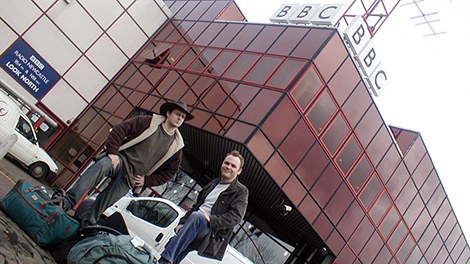20 years ago this month, our Founder & Creative Director Tom Chown enrolled on the BBC Video Journalism training course with a brief to create video content for BBC Kent’s Where I Live website. The year was 2004, and the concept of watching a video on a computer was unheard of. Here’s Tom’s story.
Published: February 2024
During my time with the BBC, I spent a year with BBC Kent’s Where I Live website as a Broadcast Journalist. We coded in Dreamweaver and Notepad (if you know, you know) with a remit to create news, features and sport stories from around the county. A revolutionary multi-million pound programme was announced by BBC Nations & Regions to train 600 journalists across the country to produce, film and edit their own videos.
My Editor at the time, Will Roffey managed to secure me a place on the residential course at Broadcasting House in Newcastle-upon-Tyne, led by a bold and visionary American, Michael Rosenblum.
IT’S (NOT) GRIM UP NORTH
Relocating to the North for a month was probably the most time I’d spent on the other side of the Thames Crossing. We were a cohort of 24 young, ambitious journalists from across the UK. We were put up in shared rooms in a hotel in Jesmond, and on our first day entered the training room at Broadcasting House.
With its funky neon lights and modern fresh design, each desk had a computer running AVID editing software and a rucksack containing a Sony PD150 camera, modified with a matte box and microphone mount for a Sennheiser 416, a pair of radio microphones, headphones and a tripod. This was a brand-new concept in broadcast cameras, a 3CCD fixed zoom lens video camera that recorded on MiniDV tapes. These were powerful tools set to revolutionise the broadcast world.


STORYTELLING IS KEY
Rosenblum shared the importance of storytelling whilst explaining how we were expected to setup our cameras, put contributors at ease whilst we did so, and then film an interview that we could craft into a story. His five-shot rule of filming everything from different angles is still something I base my filming on to this day.
At the end of each shoot Rosenblum would screen rushes (the footage) to the room, congratulating those who’d filmed five shots. Those who hadn’t, or if there were elements of the narrative missing, they were sent back to re-shoot. No-one made the same mistake twice. The 10-hour days were intense, but by the end of that first week we’d shot and edited our first video.
The NUJ and BECTU unions were in uproar, fearing mass job-losses, but this was the future of story-gathering, and empowering journalists to film and edit their own films was revolutionising our access to people’s stories. It was costly to send a Producer, Reporter and Camera Operator on location, but suddenly with just one person doing everything, we had more time to develop leads and gather stories, that previously might have been overlooked.
WORK HARD, PLAY HARD
Away from family and friends we also played hard and the comradery among our cohort and the amazing trainers we were fortunate to be paired with, led to friendships for life. My BBC South East colleague Warwick Wise and I bonded with the team from BBC Points West, Juliet Russell, Kylie Pentelow and Katherine Carpenter, as our newfound film-making skills were developed under the watchful eye of Rosenblum’s deputy Marc Perkins.


PUSHING THE BOUNDARIES
In the spring of 2004, I returned to the Tunbridge Wells newsroom with a remit to create short online films that would stream on the BBC Kent Where I Live website, using either Real player or Windows Media software. Broadband didn’t exist and most users were on 56k dial-up internet connections, therefore videos had to be heavily encoded. But technology was evolving quickly as the BBC continued to develop their own ‘streaming software’.
Later that year I travelled to Kenya with a local charity to film their HIV awareness work, which became part of the BBC’s national Africa week. After filming a series at the North Pole in 2006 with reporter Mark Norman using the same size of camera (the Sony Z1 had superseded the PD150 in just 3 years). We fed the news packages back to the UK via the internet from Svalbard in the Arctic Circle, within a record-breaking 24 hours.


GOODBYE AUNTIE (BBC)
A year later I was approached to join Bob Geldof’s production company Ten Alps as Deputy Editor, with a remit to train a team of new Video Journalists who would create content for a pioneering online TV channel. It was the first publicly funded venture in Europe that launched in September 2007, 6 weeks before the BBC managed to re-brand their ‘streaming technology’ and launch BBC iPlayer.
Two decades later, having learnt these technical film-making skills and the importance of storytelling, the question of what we want people to see, think and do when they watch our piece of content, is as relevant as ever. On-demand has revolutionised broadcasting, and online has given us a plethora of channels through which to share stories. But there’s no need to reinvent the wheel when it comes to making a film, as Rosenblum always said, “Everyone’s got a story to tell.”
That’s my story, what’s yours?




